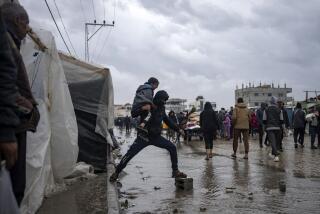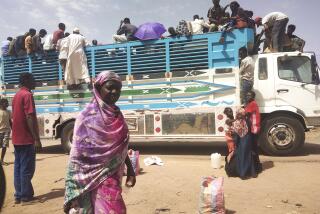In Kenya, Dadaab refugee camp faces $25-million shortfall
JOHANNESBURG, South Africa — The Dadaab refugee camp in northern Kenya is the biggest in the world, a sprawl of nearly half a million people, some of whom have lived there for about two decades.
Residents who fled famine and warfare in Somalia have now seen grandchildren born and raised in what was supposed to have been a temporary home. They have also seen predators and criminal groups flourish, and watched as recruiters lure bored and frustrated boys back to Somalia to serve in militias or pirate gangs.
Last year’s famine in southern Somalia saw Dadaab’s population swell by 160,000 to its present 465,000. As a result, Dadaab is running desperately short of funds for food and vital services, according to an appeal by several aid agencies, including Oxfam and Save the Children.
The organizations warned Thursday that they face a $25-million shortfall for their humanitarian operations in the next three months, putting 200,000 refugees at risk. From September, 50,000 refugees will have no water and sanitation facilities, the agencies say, unless new funding arrives.
They also predicted that 130,000 people could soon be without adequate shelter, living in flimsy plastic structures that deteriorate quickly in the harsh weather.
At the same time, they say, continuing to operate Dadaab as it has been run in the last two decades will not work. The camp was initially constructed to temporarily house 90,000 people. Its massive population, mostly Somalis, survives on bare subsistence-level rations, with little hope of returning to Somalia or getting work in Kenya, and with few medical or educational services.
“Refugee camps are only temporary solutions and the situation is increasingly untenable. Funds are needed now to save lives, but we can’t keep pumping money in year after year while the camp keeps getting bigger. A change in approach is urgently needed. However, right now, the world has an obligation not to turn its back on Dadaab and the needs of the people there,” Nigel Tricks, head of Oxfam in Kenya, said in a statement.
A briefing paper on Dadaab, released by the agencies Thursday, says that there are two health units for 78,000 people, and that 164,000 youngsters — 70% of the camp’s children — do not go to school, making them vulnerable to recruiters. Violence and insecurity are rife. Rapes of women and girls are common, and reports of sexual violence increased by 36% from February to May, but funding for protection of children and women has declined, according to the aid agencies.
A lack of security at the camp has also affected operations of the agencies, with several aid workers abducted from Dadaab.
Local attitudes toward the camp’s population range from indifference to hostility. Refugees compete with the local population for firewood, water and land.
Moreover, some Kenyans see the camp as a potential source of terrorists, after a series of recent attacks in the capital, Nairobi, and seaside town of Mombasa. Kenya is fighting a war against the Somali Islamist militia, the Shabab.
Reluctant to attract more refugees from Somalia, the Kenyan government has resisted providing updated sewer systems, water, schools and clinics, the advocacy organization Refugees International said in a December report.
More to Read
Sign up for Essential California
The most important California stories and recommendations in your inbox every morning.
You may occasionally receive promotional content from the Los Angeles Times.










